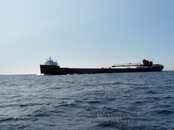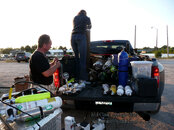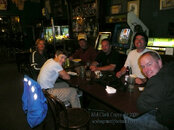Curt McNamee
Contributor
Diving the Carl D Bradley in Northern Lake Michigan, August , 2009
The Carl D Bradley was a 623 ft long self unloading bulk freighter built in 1928 which sank in 1958 with the loss of 33 men in 360 ft of water.
Here is a link to the history of the Bradley- SS Carl D. Bradley - Wikipedia, the free encyclopedia
Here is a short YouTube video regarding the sinking and bell recovery-
YouTube - November Requiem - Carl D Bradley Shipwreck
Dive Team- Mel Clark, Curt McNamee, Ron Benson, Erik Foreman, Tom Kean , Captain Jitka Hanakova and First Mate Lubo Valuch of Shipwreck Explorers- Shipwreck Explorers
The trip for Mel, Curt and Erik started with a 3 1/2 hr flight from Seattle to Milwaukee, Wisconsin with over 600 lbs of dive gear between us.
Meeting up with Ron Benson we drove for over 5 hrs North to Manistique Minnesota where the Moly V dive boat and Jitka from Shipwreck Explorers were waiting for us.
After setting up all our dive gear, the next day we were off to try our fist dive on the Bradley which is located about 20 miles east of our location in the middle of Northern Lake Michigan almost dead between the West shore town of Escanaba and the East shore town of Petoskey- Map of Lake Michigan (lake), United States - World Atlas - MSN Encarta
The weather was good and after about a 1 ½ boat ride we located the float attached to the bow right away, tied up and got ready for the dive. We were diving a 7/70 mix on our rebreathers, carried lots of bail out gas and also had an O2 station dropped from the boat with regulators set up at 20 ft. We also had many weighted lines to hold on to during our long deco and attach our bail out tanks to.
The goal on the first dive was to take pictures and video the pilot house and surrounding areas. We ascended down the line and was hit by the shock of the cold dark water at about 70 ft. The water temperature was about 65 degrees on the surface and dropped to a bone chilling 39 degrees on the way down to the bottom.
At about 250 ft, you could start to see the dark outline of bow section, the visibility was very good and there was actually some ambient light at that depth with a glow of light when looking back up towards the surface. Our max depth was around 320 ft on that dive with 25- 30 minutes on the wreck and over 3 hrs of deco.
On our second day we wanted to dive the stern half of the ship. It was generally believed that the stern was several hundred feet away from the bow section and we spent several hours looking for it with no results and we could not find the float that was suppose to mark it. So we decided to go back to the bow float to try and locate the break point on the front half on shipwreck which was about 10 cargo hold hatches aft.
After a few attempts, we finally hooked something that was solid and we decided to give it a try. On the way down this time we did not see anything at 250 ft, we kept going down deeper and deeper all the way to the bottom at 360 ft. where we found the grapple hook entangled in a line that was lying on the bottom. This line was tied to a deflated float and then headed back up at about a 30 degree angle going away from us back into the darkness.
We followed the line for a while as the clock was ticking with deco starting to build already at an alarming rate and then all of a sudden we started to sense something was in front of us And then we realized we were on the stern of the ship with the screw and rudder visible not to far away. We made a quick stop at the huge screw for some pictures, video and were in awe of what we were seeing.
Time to go up now over the stern deck with the aft emergency steerage wheels in plain site, then off to the engine room green house and engine smoke stack still all in place and in great condition. With the amount of deco scaring the **** out of me, it was time to high tail it back to the up line. That dive was incredible for all of us but we paid dearly with from 4 to 4 ½ hours to get back out of the water. Thank God for suit heaters, water proof ipod and iphone cases some of used to pass the time listening to music and watching full length movies.
The third day we were able to dive the bow section again and that is when we discovered that the aft section of the ship was not all that far away from the break and that it still might really be attached unlike what is generally believed.
We were weathered out on the fourth day but felt we were lucky to get three good dives on the Bradley. Next trip we hope to document the break between the two halves and find out weather they are really attached or separated.
It was great diving with Jitka and Lubo from Shipwreck Explorers and they did a fantastic job of running the boat and setting up for these deep dives.
Here is the link for some of the underwater pictures that Mel posted-
Carl Bradley - Rebreather World
And a couple more above water shots to finish up with our story-
The first picture is of a ship almost like the Bradley passing us in the shipping lane.
The second one is of our portable fill station.
The third is of our group kicking back talking about our 3 great dives on the Bradley
The Carl D Bradley was a 623 ft long self unloading bulk freighter built in 1928 which sank in 1958 with the loss of 33 men in 360 ft of water.
Here is a link to the history of the Bradley- SS Carl D. Bradley - Wikipedia, the free encyclopedia
Here is a short YouTube video regarding the sinking and bell recovery-
YouTube - November Requiem - Carl D Bradley Shipwreck
Dive Team- Mel Clark, Curt McNamee, Ron Benson, Erik Foreman, Tom Kean , Captain Jitka Hanakova and First Mate Lubo Valuch of Shipwreck Explorers- Shipwreck Explorers
The trip for Mel, Curt and Erik started with a 3 1/2 hr flight from Seattle to Milwaukee, Wisconsin with over 600 lbs of dive gear between us.
Meeting up with Ron Benson we drove for over 5 hrs North to Manistique Minnesota where the Moly V dive boat and Jitka from Shipwreck Explorers were waiting for us.
After setting up all our dive gear, the next day we were off to try our fist dive on the Bradley which is located about 20 miles east of our location in the middle of Northern Lake Michigan almost dead between the West shore town of Escanaba and the East shore town of Petoskey- Map of Lake Michigan (lake), United States - World Atlas - MSN Encarta
The weather was good and after about a 1 ½ boat ride we located the float attached to the bow right away, tied up and got ready for the dive. We were diving a 7/70 mix on our rebreathers, carried lots of bail out gas and also had an O2 station dropped from the boat with regulators set up at 20 ft. We also had many weighted lines to hold on to during our long deco and attach our bail out tanks to.
The goal on the first dive was to take pictures and video the pilot house and surrounding areas. We ascended down the line and was hit by the shock of the cold dark water at about 70 ft. The water temperature was about 65 degrees on the surface and dropped to a bone chilling 39 degrees on the way down to the bottom.
At about 250 ft, you could start to see the dark outline of bow section, the visibility was very good and there was actually some ambient light at that depth with a glow of light when looking back up towards the surface. Our max depth was around 320 ft on that dive with 25- 30 minutes on the wreck and over 3 hrs of deco.
On our second day we wanted to dive the stern half of the ship. It was generally believed that the stern was several hundred feet away from the bow section and we spent several hours looking for it with no results and we could not find the float that was suppose to mark it. So we decided to go back to the bow float to try and locate the break point on the front half on shipwreck which was about 10 cargo hold hatches aft.
After a few attempts, we finally hooked something that was solid and we decided to give it a try. On the way down this time we did not see anything at 250 ft, we kept going down deeper and deeper all the way to the bottom at 360 ft. where we found the grapple hook entangled in a line that was lying on the bottom. This line was tied to a deflated float and then headed back up at about a 30 degree angle going away from us back into the darkness.
We followed the line for a while as the clock was ticking with deco starting to build already at an alarming rate and then all of a sudden we started to sense something was in front of us And then we realized we were on the stern of the ship with the screw and rudder visible not to far away. We made a quick stop at the huge screw for some pictures, video and were in awe of what we were seeing.
Time to go up now over the stern deck with the aft emergency steerage wheels in plain site, then off to the engine room green house and engine smoke stack still all in place and in great condition. With the amount of deco scaring the **** out of me, it was time to high tail it back to the up line. That dive was incredible for all of us but we paid dearly with from 4 to 4 ½ hours to get back out of the water. Thank God for suit heaters, water proof ipod and iphone cases some of used to pass the time listening to music and watching full length movies.
The third day we were able to dive the bow section again and that is when we discovered that the aft section of the ship was not all that far away from the break and that it still might really be attached unlike what is generally believed.
We were weathered out on the fourth day but felt we were lucky to get three good dives on the Bradley. Next trip we hope to document the break between the two halves and find out weather they are really attached or separated.
It was great diving with Jitka and Lubo from Shipwreck Explorers and they did a fantastic job of running the boat and setting up for these deep dives.
Here is the link for some of the underwater pictures that Mel posted-
Carl Bradley - Rebreather World
And a couple more above water shots to finish up with our story-
The first picture is of a ship almost like the Bradley passing us in the shipping lane.
The second one is of our portable fill station.
The third is of our group kicking back talking about our 3 great dives on the Bradley







